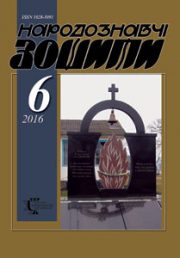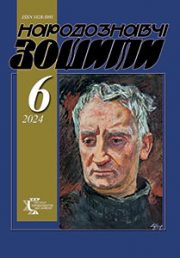The Ethnology Notebooks. 2025. № 5 (185), 1115—1125
UDK[398.34:398.4]:582.28]:140.8(=1:477.86/.87)”18/20″(091)
THE TRADITIONS OF MUSHROOM PICKING: HISTORICAL AND ETHNOGRAPHIC ASPECTS
TSURKAN Mariana
- ORCID ID: https://orcid.org/0009-0009-4267-5157
- Candidate of Historical Sciences (PhD in History),
- Researcher at the Ethnology Institute
- of National Academy of Sciences of Ukraine,
- 15, Svobody Avenue, 79000, Lviv, Ukraine,
- Contacts: e-mail: m_volowun@ukr.net
Abstract. The purpose of the article is to highlight the traditions of mushroom picking in Boikivshchyna as an integral part of the traditional culture and worldview of inhabitants of Carpathian region. In the article the idea of «mushroom happiness», ritual practices, omens and taboos of mushroom picking are highlighted. The seasonality of mushroom picking, superstitions associated with finding the first mushroom and the symbolism of mushroom picking in the folklore of Boikivshchyna region are analyzed. The main methods of processing and storing mushrooms for the winter period are described. Drying was the traditional method of storing mushrooms for the winter period in Carpathian region.
The process and the significance of mushroom picking as a supplementary household activity which integrated into the calendar cycle, family life and spiritual culture of the highlanders are investigated.
The object of the research is the process of mushroom picking in traditional culture of the highlanders as a component of household life and a bearer of ethnocultural meanings.
The subject of the article is folk beliefs, superstitions, omens, rituals, and verbal markers related to mushroom picking in everyday life of the residents of Boikivshchyna.
The author’s field ethnographic research materials in the villages of Hust and Mukachevo districts, Transcarpathian region in 2025, the ethnographic field studies T. Gontar which are preserved in the archive of the Ethnology Institute of National Academy of Sciences of Ukraine and the scientific research of the nineteenth — twenty centuries are the source base of the article.
The research methodology is based on comparative-historical and descriptive methods, an interpretative approach and principle of scientific objectivity, systematization and the author’s observations.
Keywords: Boikivshchyna, ethnography, mushroom picking, beliefs, worldview, magic.
Received 5.09.2025
REFERENCES
- Tsurkan, M. (2025). «Ya hlyp, a tam hryb, ya pryklak, a tam pyat»: beliefs, folk knowledge and omens associated with mushrooms picking in the Boіkivshchyna. Materials of the I International Scientific and Practical Conference «Boykivshchyna: Past, Present, Prospects» in honor of Volodymyr Hurkevych. Sambir [in Ukrainian].
- Kyrchiv, R. (1983). Physical and geographical characteristics of Boikivshchyna. In: Boikivshchyna: Historical and ethnographic research (Pp. 29—32). Kyiv: Naukova dumka [in Ukrainian].
- Hontar, T. (1972). Field materials on clothing and folk nutrition in Lviv, Transcarpathian and Ivano-Frankivsk regions (3 notebooks). Archive of the IN NANU. F. 1. Op. 2. Od. save 209. Notebook 2. Arc. 1—46 zv. [in Ukrainian].
- Hlavats’ka, L. (2016). Gathering as a subsidiary economic activity of the population of Eastern Boikivshchyna. The Digital Repository of the Ukrainian State University named after Mykhailo Drahomanov, 9, 268—277. Retrieved from: https://enpuir.npu.edu.ua/handle/123456789/11974 (Last accessed: 28.10.2024) [in Ukrainian].
- Hnatiuk, V. (1906). Folk food of Boikivshchyna. Scientific Collection dedicated to Prof. Mykhailo Hrushevskyi by students and followers on the occasion of his ten-year work in Galicia (1894—1904) (Pp. 591—593). Lviv: Z drukarni Naukovoho tovarystva imeny Shevchenka. Retrieved from: https://docs.google.com/viewer?url=https://shron3.chtyvo.org.ua/Hnatiuk_Volodymyr/Narodna_pozhyva_na_Boikivschyni.pdf (Last accessed: 15.07.2025) [in Ukrainian].
- Stuban, F. (1981, July — December). Boyko’s dances — «Mushroom». Litopys Boikivshchyny, 2/34 (45), 51—56 [in Ukrainian].
- Stuban, F. (1981, July — December). Mushrooms of the Boyko’s. Litopys Boikivshchyny, 2/34 (45), 48—51 [in Ukrainian].
- Hrom, H. (2002). Nahuyevychi. Drohobych: Vidrodzhennia [in Ukrainian].
- Franko, I. (Ed.). (1984). Supplements to the statistics of Ukraine. I. Forest damages and punishments in the village of Nahuyevychi. In: Collected Works: in 50 vol. (Vol. 44, book 1, pp. 82—85). Kyiv: Naukova dumka. Retrieved from: http://search.nbuv.gov.ua/cgi-bin/ua/elib.exe?Z21ID=&I21DBN=UKRLIB&P21DBN=UKRLIB&S21STN=1&S21REF=10&S21FMT=online_book&C21COM=S&S21CNR=20&S21P01=0&S21P0)2=0&S21P03=FF=&S21STR=ukr0010872 (Last accessed: 20.07.2025) [in Ukrainian].
- Kobilnyk, V. (1936). Material culture of the village of Zhukotyn, Turchanskyi region. Litopys Boikivshchyny, 7, 15—66 [in Ukrainian].
- Hnatiuk, V. (1899). Folk food and seasoning methods in Eas tern Galicia. Materialy do Ukrainsko-Ruskoi ethnologii (Vol. 1, pp. 96—110). Lviv: Z drukarni Naukovoho tovarystva imeny Shevchenka [in Ukrainian].
- Kovaliv, S. (1969). Mushrooms. In: Literaturna Boikivshchyna. Antologia (Pp. 51—58). Philadelphia [in Ukrainian].
- Hontar, T.O. (1974). Field materials on folk nutrition in the village of Hnyla, Turka district, Lviv region. Archive of the IN NANU. F. 1. Op. 2. Od. save 214. Notebook 2. Arc. 1—22 zv. [in Ukrainian].
- Zubrytskyі, M. (1895). Village of Kindrativ (Turchansyi region). Zhytie i slovo, visnyk z literatury, istory i fol’klory (Vol. 4, pp. 104—112, 216—230). Lviv: Z drykarni Instytuta Stavropihijskoho. Retrieved from: http://labs.lnu.edu.ua/folklore-studies/wp-content/uploads/sites/3/2016/02/Zhytje_i_slovo_Lviv,1895_tom4.pdf (Last accessed: 24.03.2025) [in Ukrainian].
- Onyshkevych, M. (Ed.). (1984). Dictionary of Boyko Dialects (Vol. 2). Kyiv [in Ukrainian].
- Chychula, A. (1985). Folk food in Drohobych region. Materialy do Ukrainskoi etnologii (Vol. 8, pp. 12—31). Lviv: Z drukarni Naukovoho tovarystva imeny Shevchenka [in Ukrainian].
- Retrieved from: http://chytanka.com.ua/static/663.ukr.html (Last accessed: 25.03.2025).
- Onyshkevych, M. (Ed.). (1984). Dictionary of Boyko Dialects. (Vol. 1). Kyiv [in Ukrainian].
- Falkowski, Ya. (1935). Village of Volosate, Lisk region. Litopys Boikivshchyny, 5, 14—28 [in Ukrainian].
- Hontar, T.O. (1973). Field materials on clothing and folk nutrition in Ivano-Frankivsk, Lviv, Chernivtsi regions. 1973. Archive of the IN NANU. F. 1. Op. 2. Od. save 212. Arc. 1—81 zv. [in Ukrainian].
- Dmytrenko, A., & Hrymych, Maruna. (Ed.). (2012). Women’s labor specialzations: picking (collecting). Folk culture of Ukraine: the lifecycle of the person. Historical and ethnological research: in the 5th vol. Maturity. Womenfolk. Women’s subculture. (Vol. 3, pp. 20— 51). Kyiv: Duliby [in Ukrainian].
- Hontar, T.O. (1972). Field materials on clothing and folk nutrition in Lviv, Transcarpathian and Ivano-Frankivsk regions (3 notebooks). Archive of the IN NANU. F. 1. Op. 2. Od. save 209. Notebook 1. Arc. 1—47 zv. [in Ukrainian].
- Hontar, T.O. (1974). Field materials on folk nutrition in Lviv and Ivano-Frankivsk regions. Archive of the IN NANU. F. 1. Op. 2. Od. save 213. Arc. 1—83 zv. [in Ukrainian].
- Hontar, T.O. (1983). Nutrition. In: Boikivshchyna: Historical and ethnographic research (Pp. 149—155). Kyiv: Naukova dumka [in Ukrainian].
- Franko, I. (1898). Folk beliefs in the Podhorye region (based on the materials from the village of Nahuyevychi, cities of Drohobych, Kolomyia and some villages of Drohobych and Stryi regions). Etnographichnyi zbirnyk (Vol. 5, pp. 160—208). Lviv: Z drukarni Naukovoho tovarystva imeny Shevchenka [in Ukrainian].
- Kolessa, F. (1898) Folk beliefs in the Podhorye region (village of Khodovychi, Stryi Country). Etnographichnyi zbirnyk (Vol. 5, pp. 76—98) [in Ukrainian]
- Skrupnyk, H. (Ed.). (2016). Ethnographic image of modern Ukraine. Corps of expeditionary folklore and ethnographic materials. Calendar rituals (Vol. 6). NAN Ukrainy; IMFE named after M.T. Rylsky. Kyiv [in Ukrainian].
- Turians’ka, M. (1934). Boyko’s customs during Christmas, New Year, and Jordan (Ternova Vyzhnia, Turka region). Litopys Boikivshchyny, 3, 23—27 [in Ukrainian].
- Serebriakova, O. (2024). Christmas Magic Mushroom Har vesting (Based on the Field research Materials of Boikivshchyna). The Carpatians: populace, ethnos, civilization (Vol. 10, pp. 209—219). Ivano-Frankivsk [in Ukra i nian].
- Hromova, N. (2006). Christmas Eve in a modern Boyko’s village. Ethnic History of European Nations (Vol. 21, pp. 89—96). Kyiv. Retrieved from: http://ethnic.history.univ.kiev.ua/data/2006/21/articles/15.pdf (Last accessed 25.03.2025) [in Ukrainian].
- Retrieved from: https://nashe.com.ua/song/22221 (Last accessed: 27.03.2025).
- Zhayvoronok, V. (2006). Signs of Ukrainian ethnoculture: a dictionary-reference. NAN Ukrainy; Institute of Linguistics named after A.A. Potebnya. Kyiv [in Ukrainian].
- Retrieved from: http://8next.com/rizdvo/9586-prikmeti.htm (Last accessed: 27.03.2025).
- Retrieved from: https://www.rbc.ua/rus/news/gribi-ki-peredbachayut-maybutne-prikmeti-1756136393.html (Last accessed: 27.03.2025).






